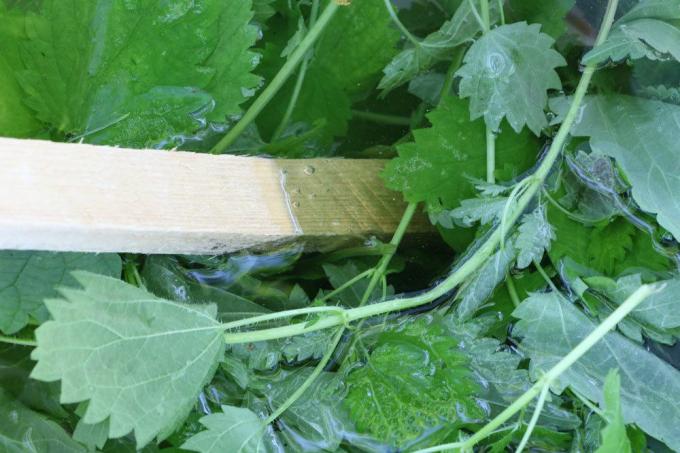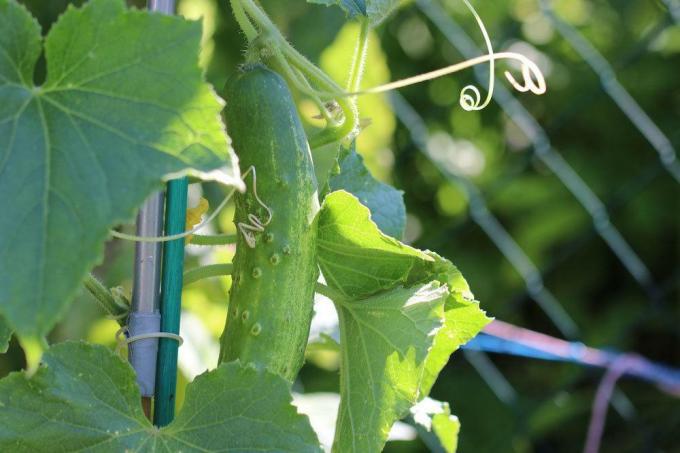
table of contents
- Differentiate between real and downy mildew
- Fight powdery mildew
- Immediate action
- Home remedies
- Fungicides
- Control in the greenhouse
- Prevent infestation
- Maintain crop rotation
- Use resistant varieties
Cucumber powdery mildew is not only an annoying disease, if left unchecked it can even kill the crop. The first sign are spots on the plants. It is important to distinguish which form the disease is. There are two different forms of fungal infection, but they must be combated in a similar way, but require different conditions for growth.
Differentiate between real and downy mildew
Both fungal diseases affect cucumber plants and have similar symptoms, including white discoloration, for example. The fungal disease should not be underestimated, because within a very short time not only a whole series of leaves, but the entire plant is attacked. The advantage, however, is that cucumber powdery mildew specializes exclusively in cucumbers and does not affect other vegetable crops. If other cultures have comparable symptoms, it is indeed the same fungal disease, but again a form specialized in this genus.
Powdery mildew fungus:
- occurs in dry and warm climates
- white floury spots on the upper side of the leaf
- Transmission by wind or insects
The damage pattern of the downy mildew fungus looks similar, but it develops much faster, but often goes unnoticed, especially in the early stages.
Downy mildew fungus:
- Formation on the underside of the leaf
- white to yellowish spots
- occurs at very high humidity

right: downy mildew
Fight powdery mildew
Immediate action
As soon as an infestation has been found on the cucumbers, you should act immediately. The powdery mildew spreads very quickly and can lead to the death of the plant within a few weeks. As soon as color changes are noticed on the leaves, action must be taken. If you wait for leaves to die, it is often too late and the plant is largely infected. Therefore, the underside of the cucumber plants should also be checked regularly to detect the wrong powdery mildew fungus. Infested parts of the plant are removed and disposed of as an immediate measure. The fungus can also attack flowers and fruits, which are also no longer eaten but disposed of.
Plants resp. Plant parts that are infected must not be disposed of on the compost, as the fungal spores can withstand low temperatures undamaged. In the worst case, they are spread over the entire garden via the compost and can infect crops again and again, even if they change location. Therefore, you should only use the infected parts of the plant residual waste dispose.
Home remedies
milk
A successful remedy for fungal diseases of all kinds is milk. Ideally, raw milk is used directly by the farmer, but commercial milk can also be used. However, milk from the supermarket should be kept in a warm place for at least 24 hours so that sufficient lactic acid bacteria can develop. The lactic acid cultures form a protective layer around the plant parts. On the one hand, this prevents the fungus from spreading and also combats the infestation, even if effects such as white spots are not yet visible.
The lactic acid bacteria themselves do not harm the plant - on the contrary, they even promote the organisms in the soil. For use, the milk is diluted 1: 1 with water and sprayed onto the plant. In the first few days it smells a bit unpleasant, but the smell disappears after a while.
tip: You can use the mixture of milk and water on young plants to prevent infestation. With repeated use, you should avoid fruits that are about to be harvested so that they do not have an unpleasant taste.
garlic
Garlic is also a good home remedy for various fungal diseases. To do this, roughly cut the garlic, pour boiling water on it and spray the affected plants with the cooled broth.
Nettle manure
Both to strengthen the plants and in the fight against powdery mildew, the Nettle manure proven. To do this, roughly chop stinging nettles, put them in a bucket and fill it up with water. The broth is left covered in a sunny to partially shaded place for several weeks. If odors develop, you can use stone flour to bind them. As soon as the nettles are largely decomposed, you can spray or water the broth in a dilution of 1 part nettle broth to 10 parts water on the plants.

tip: Baking soda can also be used to combat powdery mildew. To do this, dissolve 2 teaspoons of baking soda in one liter of water and spray the plants with it again.
Fungicides
As an alternative to home remedies, you can also use commercially available fungicides. However, since the cucumbers are foodstuffs, instructions for use and, above all, waiting times must be strictly adhered to. Therefore, only use fungicides in an extreme emergency. Products from the trade based on sulfur have proven themselves.
Control in the greenhouse
A particular problem area is the control of powdery mildew on cucumbers in the greenhouse. Due to the almost closed space, the mushrooms often spread much faster. In the greenhouse, you should therefore take special preventive and control measures:
- ventilate regularly and thin out plants
- Remove diseased parts of the plant
- Disinfect plant sticks before use
- Change tie-up material annually
tip: In greenhouses, there is a higher probability of creating ideal climatic conditions for fungal attack. With a weather station that measures humidity and temperature, you can react in time and critical climatic areas that favor the spread of powdery mildew should be avoided in advance will.
Prevent infestation
Gardeners can take preventive measures against powdery mildew on cucumber plants. Above all, strengthening the immune system of the plants has proven to be beneficial. If an initial infestation occurs, you can prevent it from spreading by strengthening the cucumber plants and removing the infected parts of the plant.
The following preventive measures are taken:
- Horsetail broth for casting to strengthen the cell structure
- Water close to the ground and avoid moisture on the leaves
- Plant cucumbers with sufficient spacing
- Avoid over-fertilization
- Mixed culture partner like planting onion or garlic
- Keep cucumber plants free from weeds
When choosing cucumbers, you should only use healthy and strong plants. Plants that are already sickly or weak should not be planted in the first place. They offer the fungal spores a good attack surface and can thus encourage them to spread to neighboring plants.
Maintain crop rotation
A very decisive factor in effectively combating powdery mildew is compliance with the crop rotation. Due to the fact that the fungus can easily survive in the soil for several years, you should definitely change location in the event of an infestation.
Do not plant cucumbers in locations where there were previously carrots or potatoes. The nematodes that form around the carrots can damage the cucumber plants. Fungal diseases can develop in potatoes, which, like powdery mildew, can damage cucumbers.
As a successor at locations with cucumber plants, you can plant broad beans, various types of cabbage, radishes or leeks, for example. In this way, you do not offer cucumber powdery mildew a breeding ground again in the next year and can fight it in the long term.
Use resistant varieties
Powdery mildew is a fungal disease that can occur again and again due to its resistance. Especially in gardens with limited space, where crop rotation is hardly possible, it causes great problems. Even those who consistently fight powdery mildew can sometimes despair of the persistent occurrence of the fungal disease. Varieties that have limited or limited resistance bring relief. are very resistant to this fungal infection. As a result, the effort involved in prevention or control is lower.
Resistant varieties of pickling cucumbers:
- Charlotte
- Excelsior
- Hok
- Zicron
Resistant varieties in snake cucumbers:
- Cordoba
- flamingo
- Hayat
- Sudica

Note: Although these varieties have a certain resistance, they should also be selected when they are planted out. The healthier and stronger the plants are, the greater their chance of surviving not only against powdery mildew, but also against other pests and diseases.




